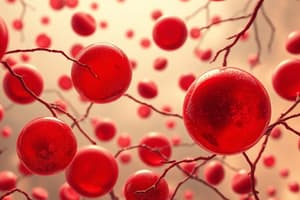Podcast
Questions and Answers
What is the primary function of the Catulase enzyme?
What is the primary function of the Catulase enzyme?
- Convert H2O2 to H2O and O2 (correct)
- Convert free radicals to hydrogen peroxide
- Convert O2 to H2O2
- Convert O2 to free radicals
What is the main reason behind the enlargement of the abdomen in individuals with thalassemia?
What is the main reason behind the enlargement of the abdomen in individuals with thalassemia?
- Liver inflammation
- Gastrointestinal bleeding
- Enlarged or swollen spleen (correct)
- Kidney dysfunction
What is the fate of bilirubin once it is conjugated in the liver?
What is the fate of bilirubin once it is conjugated in the liver?
- It becomes part of the bile in the gallbladder
- It is excreted as urobilinogen in the small intestine (correct)
- It is converted to biliverdin in the large intestine
- It gets reabsorbed in the kidney tubules
What happens to RBC flexibility after 100-140 days?
What happens to RBC flexibility after 100-140 days?
What is the primary role of glutathione in its reduced form?
What is the primary role of glutathione in its reduced form?
In which reaction of the Hexose monophosphate shunt pathway does the enzyme glucose-6-phosphate dehydrogenase play a crucial role?
In which reaction of the Hexose monophosphate shunt pathway does the enzyme glucose-6-phosphate dehydrogenase play a crucial role?
What is the primary function of the Hexose monophosphate shunt pathway?
What is the primary function of the Hexose monophosphate shunt pathway?
What is the significance of NADPH generated in the Hexose monophosphate shunt pathway?
What is the significance of NADPH generated in the Hexose monophosphate shunt pathway?
What is the main consequence of oxidative stress on the body?
What is the main consequence of oxidative stress on the body?
Which enzyme is involved in the first reaction of the Hexose monophosphate shunt pathway?
Which enzyme is involved in the first reaction of the Hexose monophosphate shunt pathway?
Flashcards are hidden until you start studying
Study Notes
Catulase Enzyme Function
- Catulase acts as a catalyzer to convert hydrogen peroxide into water and oxygen, protecting cells from oxidative damage.
Thalassemia and Abdominal Enlargement
- Individuals with thalassemia experience abdominal enlargement mainly due to splenomegaly, as the spleen works harder to filter abnormal red blood cells.
Fate of Bilirubin After Conjugation
- Once conjugated in the liver, bilirubin is transformed into a water-soluble form that can be excreted in bile or urine, thereby aiding in the elimination of waste.
RBC Flexibility After 100-140 Days
- After 100-140 days, red blood cells (RBCs) lose their flexibility, contributing to their recognition and destruction by the spleen.
Role of Glutathione
- In its reduced form, glutathione serves as a crucial antioxidant, protecting cells from oxidative stress by neutralizing reactive oxygen species.
Glucose-6-Phosphate Dehydrogenase in Hexose Monophosphate Shunt
- Glucose-6-phosphate dehydrogenase catalyzes the first step of the hexose monophosphate shunt pathway, which is critical for generating NADPH.
Primary Function of Hexose Monophosphate Shunt Pathway
- The hexose monophosphate shunt pathway is primarily responsible for producing NADPH and ribose-5-phosphate, vital for nucleotide synthesis and reducing agents.
Significance of NADPH in Hexose Monophosphate Shunt
- NADPH generated in the hexose monophosphate shunt is essential for biosynthetic reactions, including fatty acid synthesis and maintaining glutathione in its reduced form.
Consequence of Oxidative Stress
- Oxidative stress can lead to cellular damage, inflammation, and diseases such as cancer, cardiovascular disorders, and neurodegeneration.
First Reaction Enzyme of the Hexose Monophosphate Shunt
- The enzyme involved in the first reaction of the hexose monophosphate shunt pathway is glucose-6-phosphate dehydrogenase, initiating the pathway's crucial processes.
Studying That Suits You
Use AI to generate personalized quizzes and flashcards to suit your learning preferences.



